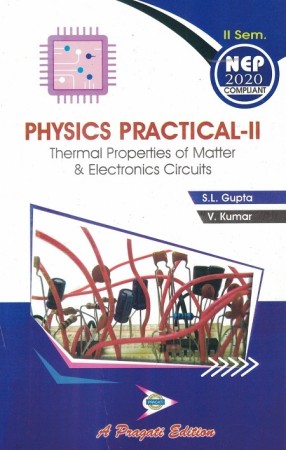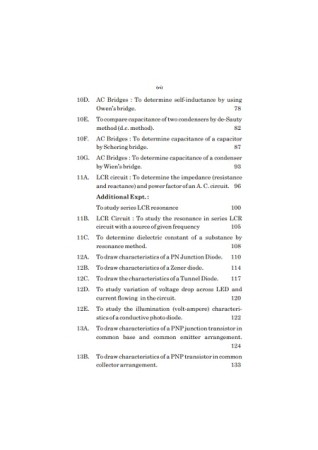









0 Reviews
548 Views
The syllabi for postgraduate and graduate classes of all Indian Universities have been modified as per the guidelines of NEP. In order to adhere to th .... Read More
The syllabi for postgraduate and graduate classes of all Indian Universities have been modified as per the guidelines of NEP. In order to adhere to the modified syllabus, we have updated our popular book 'Practical Physics'.
| Sr | Chapter Name | No Of Page |
|---|---|---|
| 1 | 1. To determine mechanical equivalent of heat by using Callendar and Barne’s constant flow calorimeter | 4 |
| 2 | 2. To determine coefficient of thermal conductivity of a metal (copper), by using Searle’s apparatus | 7 |
| 3 | 3. To determine coefficient of thermal conductivity of rubber in the form of a tube | 5 |
| 4 | 4. To determine coefficient of thermal conductivity of a non-metallic solid (bad conductor) by Lee’s disc method. | 5 |
| 5 | 5. To determine value of Stefan’s constant. | 6 |
| 6 | 6. To verify Stefan’s law. | 6 |
| 7 | 7. Variation of thermo-emf across two junctions of a thermocouple with temperature | 8 |
| 8 | 8. To determine temperature coefficient of resistance for Platinum, using a platinum resistance thermo-meter, and a Callender and Griffith’s bridge. | 11 |
| 9 | 9A. To study charge and discharge of a condenser through a resistance (CR circuit). | 7 |
| 10 | 9B. To study charge and discharge of a condenser through a resistor. | 4 |
| 11 | 10A. AC Bridges : To determine self inductance by Anderson’s method. | 5 |
| 12 | 10B. AC Bridges : To determine self-inductance by Maxwell’s L/C bridge. | 6 |
| 13 | 10C. AC Bridges : To determine self-inductance of a given coil by Maxwell’s inductance bridge. | 3 |
| 14 | 10D. AC Bridges : To determine self-inductance by using Owen’s bridge. | 4 |
| 15 | 10E. To compare capacitance of two condensers by de-Sauty method (d.c. method). | 5 |
| 16 | 10F. AC Bridges : To determine capacitance of a capacitor by Schering bridge. | 6 |
| 17 | 10G. AC Bridges : To determine capacitance of a condenser by Wien’s bridge. | 3 |
| 18 | 11A. LCR circuit : To determine the impedance (resistance and reactance) and power factor of an A. C. circuit. | 9 |
| 19 | 11B. LCR Circuit : To study the resonance in series LCR circuit with a source of given frequency | 3 |
| 20 | 11C. To determine dielectric constant of a substance by resonance method. | 2 |
| 21 | 12A. To draw characteristics of a PN Junction Diode. | -6 |
| 22 | 12B. To draw characteristics of a Zener diode. | 13 |
| 23 | 12C. To draw the characteristics of a Tunnel Diode. | 3 |
| 24 | 12D. To study variation of voltage drop across LED and current flowing in the circuit. | 2 |
| 25 | 12E. To study the illumination (volt-ampere) characteri- stics of a conductive photo diode. | 2 |
| 26 | 13A. To draw characteristics of a PNP junction transistor in common base and common emitter arrangement. | 9 |
| 27 | 13B. To draw characteristics of a PNP transistor in common collector arrangement. | 4 |
| 28 | 14. Half wave, Full wave rectification. To study half wave full wave power supply with L and π section filters. | 5 |
| 29 | 15. Unregulated and regulated power supply : To study the regulation characteristics of a Zener regulated and IC 741 regulated power supply. | 5 |
| 30 | 16A. To study waveform's phase and frequency by CRO | 4 |
| 31 | 16B. To measure the d.c. and a.c. voltages by cathode ray oscilloscope. | 4 |
| 32 | 17. To determine the specific heat of liquid (glycerine) using Newton's law of cooling. | 7 |
| 33 | 18. Common collector characteristics to study voltage gain, input impedance, output impedance, and power gain of common collector transistor or an emitter follower. | 4 |
| 34 | 19. To study characteristics of an integrating and differentiating circuit. | 4 |